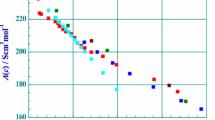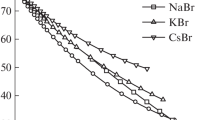Abstract
Systematic and precise measurements of electrical conductivities of dilute aqueous solutions of cadmium bromide and cadmium iodide were performed from 15 to 35 °C. The conductances were interpreted in terms of a molecular model that includes a mixture of two 1:1 and 2:1 electrolytes. The molar limiting conductances of \( \lambda \) 0(CdX+, T) ions, the equilibrium constants of formation of CdX+ complexes K(T) and the corresponding standard thermodynamic functions were evaluated using the Quint–Viallard conductance equations, the Debye–Hückel equations for activity coefficients and the mass action equations. Mathematical representations are also presented to an extension of molecular models, to the simultaneous formation of MeX+ and MeX2 species and to the possibility of hydrolysis reactions with formation of Me(OH)+ ions.



Similar content being viewed by others
References
MacInnes, D.A.: The Principles of Electrochemistry, vol. 194, pp. 88–91. Dover, New York (1961)
Robinson, R.A., Stokes, R.H.: Electrolyte Solutions, 2nd edn, pp. 425–429. Butterworths, London (1965)
Kortüm, G.: Treatise on Electrochemistry, 2nd edn, pp. 238–240. Elsevier, Amsterdam (1965)
Butler, J.N., Cogley, D.R.: Ionic Equilibrium. Solubility and pH Calculations, pp. 240–256. Wiley, New York (1998)
Davies, C.W.: The Conductivity of Solutions, pp. 163–168. Wiley, New York (1930)
Riley, H.L., Gallafent, V.: A potentiometric investigation of electrolytic dissociation. Part I. Cadmium halides. J. Chem. Soc. 514–523 (1932)
Bates, R.G., Vosburgh, V.C.: Equilibria in cadmium iodide solutions. J. Am. Chem. Soc. 60, 137–141 (1938)
Korenman, I.M.: The instability constant of CdCl4 2−. Zh. Obshchei Khim. 18, 1233–1236 (1948)
Strocchi, P.M.: Contributo alla conoscenza del complessi del mercurio, cadmio, zinco. Note I. Gazz. Chim. Ital. 79, 41–50 (1949)
Strocchi, P.M.: Complessi del mercurio, cadmio, zinco. Note II. Gazz. Chim. Ital. 79, 270–279 (1949)
Strocchi, P.M.: Ricerche polarografiche sugli ioni complessi, I. Complessi alogenati del cadmio. Gazz. Chim. Ital. 80, 234–248 (1950)
Eriksson, L.: The complexity constants of cadmium chloride and bromide. Acta Chem. Scand. 7, 1146–1154 (1953)
Vanderzee, C.E., Dawson Jr., H.L.: The stability constants of cadmium complexes: variation with temperature and ionic strength. J. Am. Chem. Soc. 75, 5659–5663 (1953)
Gerding, P.: Thermochemical studies in metal complexes. I. Free energy, enthalpy, and entropy changes for stepwise formation of cadmium(II) halide complexes in aqueous solution at 25 °C. Acta Chem. Scand. 20, 79–94 (1966)
Lutfullah, Paterson, R.: Stability constants for cadmium iodide complexes in aqueous cadmium iodide (298.15 K). J. Chem. Soc., Faraday Trans. I 74, 484–489 (1978)
Marcus, Y.: Studies on the hydrolysis of metal ions. Part 20. The hydrolysis of the Cd ion, Cd2+. Acta Chim. Scand. 11, 690–692 (1957)
Biedermann, G., Ciavatta, L.: Studies on the hydrolysis of metal ions. Part 41. The hydrolysis of the cadmium ion, Cd2+. Acta Chim. Scand. 16, 2221–2239 (1962)
Dyrssen, D., Lumme, P.: Studies on the hydrolysis of metal ions. 40. A liquid distribution study of the hydrolysis of Cd2+. Acta Chim. Scand. 16, 1785–1793 (1962)
Matsui, H., Othaki, H.: A study on the hydrolysis of cadmium ion in aqueous 3 M (Li)ClO4 solution. Bull. Chem. Soc. Japan 47, 2603–2604 (1974)
Rai, D., Felmy, R.A., Szelmeczka, R.W.: Hydrolysis constants and ion-interaction parameters for cadmium(II) in zero to high concentration of sodium hydroxide–potassium hydroxide, and the solubility product of crystalline cadmium hydroxide. J. Solution Chem. 20, 375–390 (1991)
Lucasse, W.W.: The transference numbers of cadmium chloride and bromide. J. Am. Chem. Soc. 51, 2605–2608 (1929)
Leden, I.: Einige potentiometrische messungen zur bestimmung der komplexionen in cadmiumsalzlösungen. Z. Physik. Chem. A188, 160–181 (1941)
Alberty, R.A., King, E.L.: Moving boundary systems formed by weak electrolytes. Study of cadmium iodide complexes. J. Am. Chem. Soc. 75, 517–523 (1951)
Vasilev, A.M., Proukhina, V.I.: Polarographic study of the stability of chlorine and bromine complexes of cadmium and lead. Zh. Anal. Khim. 6, 218–222 (1951)
Korshunov, I.A., Malyugina, N.I., Balabanova, O.M.: Polarographic study of complexes of cadmium with some univalent anions. Zh. Obshchei Khim. 21, 620–625 (1951)
Korshunov, I.A., Malyugina, N.I., Balabanova, O.M.: Polarographic study of complexes of cadmium with some univalent anions. Zh. Obshchei Khim. 21, 685–690 (1951)
Marple, L.W.: The sorption of metal complex species by anion exchange resin. I. Verification of the theoretical treatment of ion exchange equilibria based on the partition of uncharged complex species. J. Inorg. Nucl. Chem. 27, 1693–1700 (1965)
Paterson, R., Anderson, J., Anderson, S.S.: Transport in aqueous solutions of group IIB metal salts at 298.15 K. Part 2. Interpretation and prediction of transport in dilute solutions of cadmium iodide. An irreversible thermodynamic analysis. J. Chem. Soc., Faraday Trans. I 73, 1773–1788 (1977)
Ramette, R.M.: Equilibrium constants for cadmium bromide complexes by coulometric determination of cadmium iodate solubility. Anal. Chem. 55, 1232–1236 (1983)
Pethybridge, A.: Study of association in unsymmetrical electrolytes by conductance measurements Part 1 Non-aqueous solutions. Z. Physik. Chem. N. F. 133, 143–158 (1982)
Harned, H.S., Owen, B.B.: The Physical Chemistry of Electrolytic Solutions, 3rd edn. Reinhold, New York (1958)
Davies, C.W.: Ion Association. Butterworths, London (1962)
Fuoss, R.M., Edelson, D.: Bolaform electrolytes. I Di-(β-trimethylammonium ethyl)succinate dibromide and related compounds. J. Am. Chem. Soc. 73, 269–273 (1951)
Lee, W.H., Wheaton, R.J.: Conductance of symmetrical, unsymmetrical and mixed electrolytes. Part 1. Relaxation terms. J. Chem. Soc., Faraday Trans. 2 74, 743–766 (1978)
Lee, W.H., Wheaton, R.J.: Conductance of symmetrical, unsymmetrical and mixed electrolytes. Part 2. Hydrodynamic terms and complete conductance equation. J. Chem. Soc. Faraday Trans. 2 74, 1456–1482 (1978)
Quint, J., Viallard, A.: Relaxation field for the general case of electrolyte mixtures. J. Solution Chem. 7, 137–153 (1978)
Quint, J., Viallard, A.: The electrophoretic effect for the case of electrolyte mixtures. J. Solution Chem. 7, 525–531 (1978)
Quint, J., Viallard, A.: Electical conductance of electrolyte mixtures of any type. J. Solution Chem. 7, 533–548 (1978)
Quint, J.: Contribution a l’étude de la conductibilité électrique de mélanges d’électrolytes. PhD. thesis, University of Clermont–Ferrand, April (1976)
Chandler, E.E.: The ionization constants of the second hydrogen ion of dibasic acids. J. Am. Chem. Soc. 30, 694–713 (1909)
Kohlrausch, F., Holborn, L.: Das leitvermögen der elektolyte. insbesondere der lösungen. methoden, resultate und chemische anwendungen. Druck und Verlag von B.G. Teubner, Leipzig, (1889)
Jones, H.C.: The electrical conductivity, dissociation and temperature coefficient of conductivity (from zero to sixty-five degrees) of aqueous solutions of a number of salts and organic acids. Carnegie Institution of Washington, Publ. № 170, 48–49 (1912)
Noyes, A.A., Falk, K.G.: The properties of salt solutions in relation to the ionic theory. III Electrical conductance. J. Am. Chem. Soc. 34, 454–485 (1912)
Fedotov, N.V.: Conductivity of dilute aqueous solutions of cadmium salts in the 25–80° temperature range. Zhurn. Prikl. Khim. 51, 2091–2093 (1978)
Apelblat, A., Esteso, M.A., Bester-Rogac, M.: A conductivity study of unsymmetrical 2:1 type “complex ion” electrolyte: cadmium chloride in dilute aqueous solutions. J. Phys. Chem. B 117, 5241–5248 (2013)
Kümmell, G.: Die Ueberführungszahlen von Zn—und Cd—Salzen sehr verdünnten Lösungen. Ann. Physik (Leipzig) N. F. 64, 655–679 (1898)
Wolten, G.M., King, C.V.: Transference numbers of zinc and cadmium sulfates at 25°, as functions of the concentration. J. Am. Chem. Soc. 71, 576–578 (1949)
Lang, R.E., King, C.V.: Transference numbers in aqueous zinc and cadmium sulfates. J. Am. Chem. Soc. 76, 4716–4718 (1954)
Apelblat, A., Azoulay, D., Sahar, A.: Properties of aqueous thorium nitrate solutions I. Densities, viscosities, conductivities, pH, solubility and activity at freezing point. J. Chem. Soc., Faraday Trans. 69, 1618–1623 (1973)
Kielland, J.: Individual activity coefficients of ions in aqueous solutions. J. Am. Chem. Soc 59, 1675–1678 (1937)
Apelblat, A., Neueder, R., Barthel, J.: Electrolyte Data Collection. Electrolyte Conductivities and Dissociation Constants of Aqueous Solutions of Organic Monobasic Acids CH2O2–C7H14O3. Chemistry Data Series XII, part 4a, Dechema, Frankfurt am Main (2004)
Apelblat, A.: Dissociation constants and limiting conductances of organic acids in water. J. Mol. Liquids 95, 99–145 (2002)
Brummer, S.B., Hills, G.J.: Kinetics of ionic conductance. Part 1.—Energies of activation and the constant volume principle. Trans. Faraday Soc. 57, 1816–1822 (1961)
Acknowledgments
The author appreciate very much Paulina Veinner for her competent technical assistance.
Author information
Authors and Affiliations
Corresponding author
Appendix: Chemical Equilibria and Conductance Equations in Cases of Formation of Neutral Species and Hydrolysis
Appendix: Chemical Equilibria and Conductance Equations in Cases of Formation of Neutral Species and Hydrolysis
An extension of molecular model to formation in solution of the neutral MeX2 species is governed by the following chemical reactions:
and in terms of the mass-action equations:
Denoting the fractions of Me2+ and MeX+ ions in solution as α and β, respectively, from the charge and material balance we have:
Introducing Eq. 18 into Eq. 17, the chemical equilibrium equations take the form
For every concentration c, the fractions α and β can be successively evaluated by an iterative solution of two quadratic equations:
where
Molar conductance of electrolyte Λ(c, T) in this case from Eq. 1 is:
and in terms of the ion pairs (Me2+ + X−) and (MeX+ + X−) is:
Thus, essentially the form of conductivity equations remains the same as in Eq. 11, but the appearance of neutral MeX2 species reduces the total number of ions in solution.
In the simplest case of hydrolysis process, the following reactions occur:
The mass-action equations of the complexation and hydrolysis processes are:
In this case, from the material and charge balance we have:
and therefore
This gives the set of three equations that should be solved by an iterative procedure:
where
The ionic contributions to the molar conductance Λ(c, T) are given by:
In order to apply the Quint–Viallard conductance equation, the following conductances of six pairs of ions should be introduced:
Arranging (31) with using (30), the molar conductance of solutions is given by:
Rights and permissions
About this article
Cite this article
Apelblat, A. Representation of Electrical Conductances by the Quint–Viallard Conductivity Equation. Part 6. Unsymmetrical 2:1 Type “Complex Ions” Electrolytes: Cadmium Bromide and Cadmium Iodide. J Solution Chem 45, 1130–1145 (2016). https://doi.org/10.1007/s10953-016-0493-7
Received:
Accepted:
Published:
Issue Date:
DOI: https://doi.org/10.1007/s10953-016-0493-7




